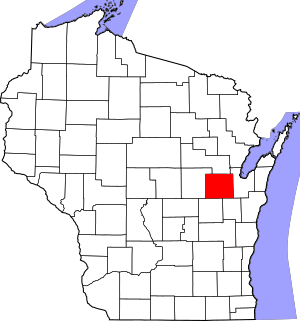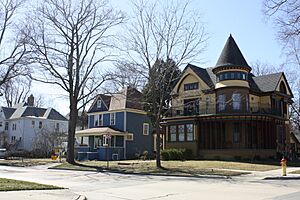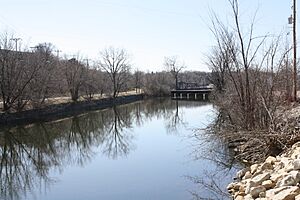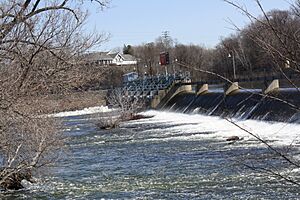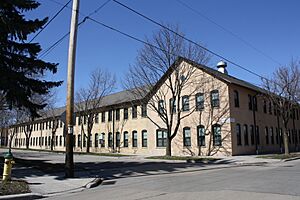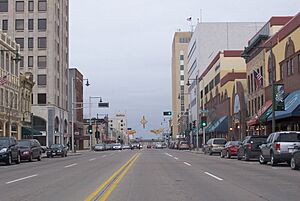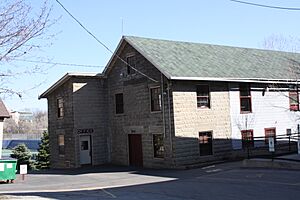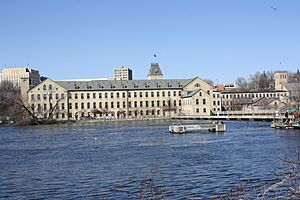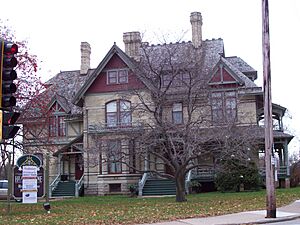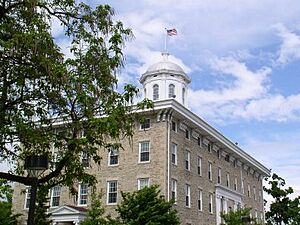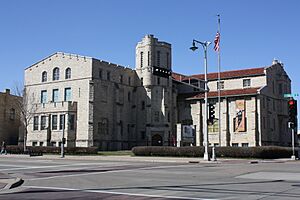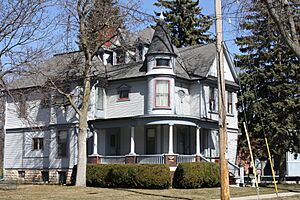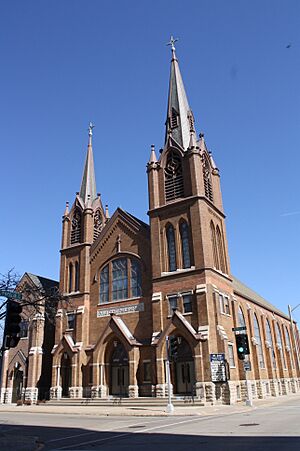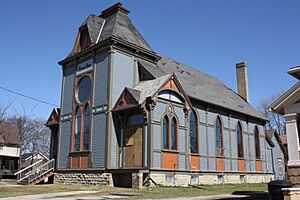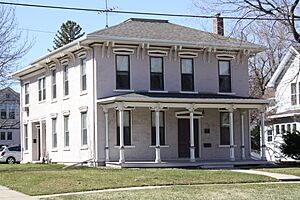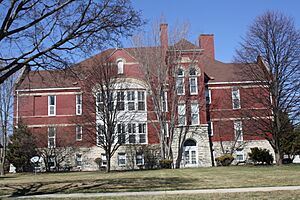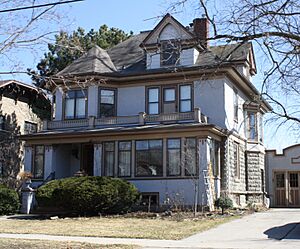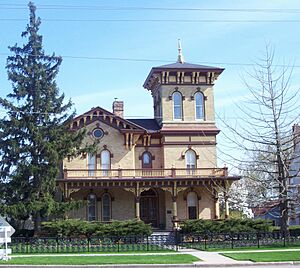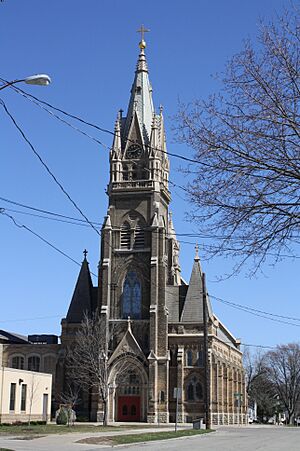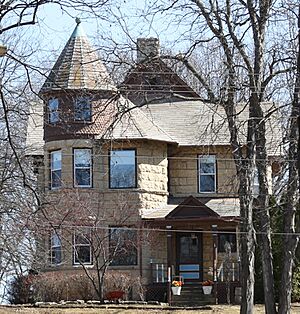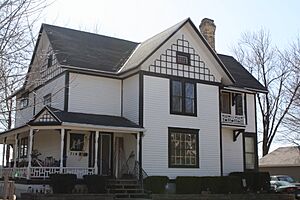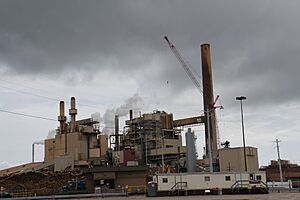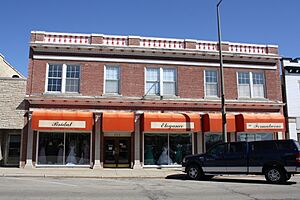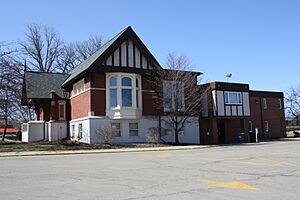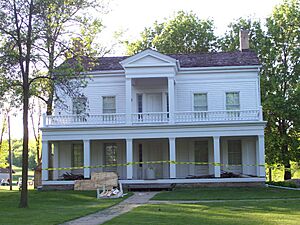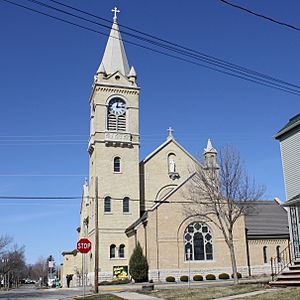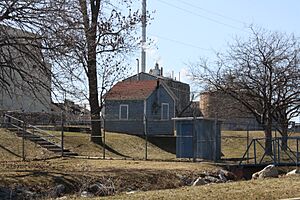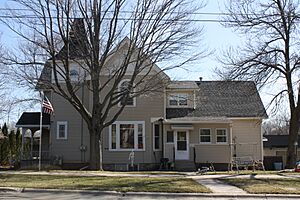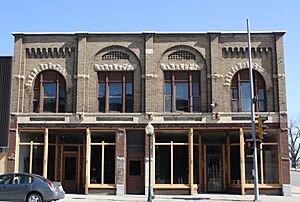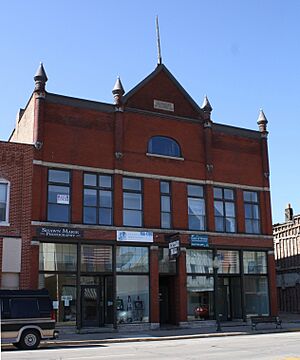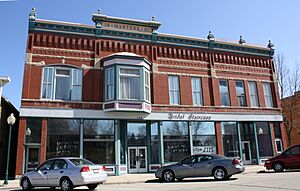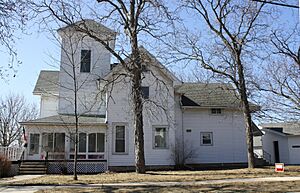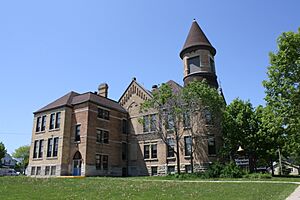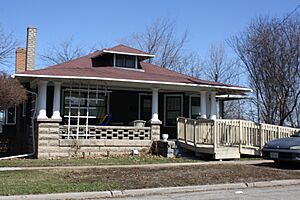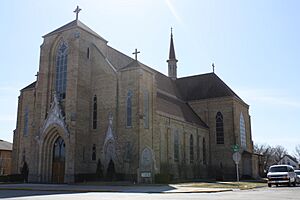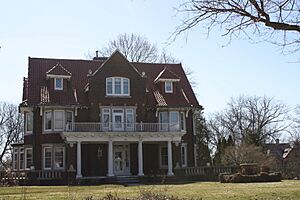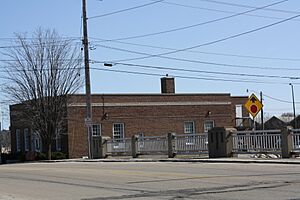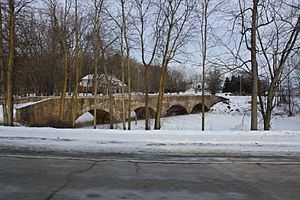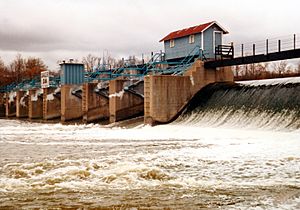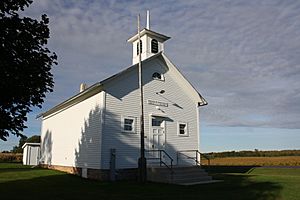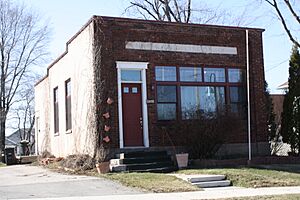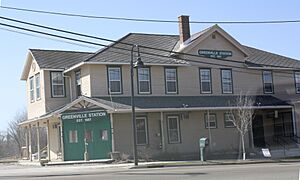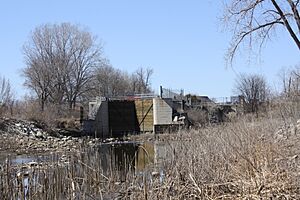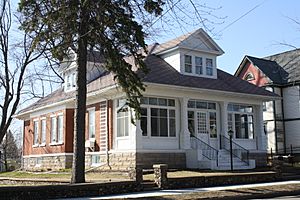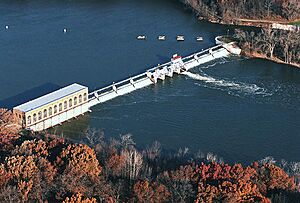National Register of Historic Places listings in Outagamie County, Wisconsin facts for kids
Welcome to a special list of amazing places in Outagamie County, Wisconsin! These are buildings, bridges, and areas that are super important because of their history. They are all listed on the National Register of Historic Places, which is like a hall of fame for historic sites in the United States.
There are 50 of these special places in Outagamie County. One place used to be on the list but was removed. Let's explore some of these cool spots!
Contents
- Historic Places You Can Visit
- Appleton's Historic Gems
- Appleton City Park Historic District
- Appleton Locks 1-4 Historic Districts
- Appleton Wire Works
- Appleton Woolen Mills
- College Avenue Historic District
- J. B. Courtney Woolen Mills
- Fox River Paper Company Historic District
- Hearthstone Historic House Museum
- Main Hall, Lawrence University
- The History Museum at the Castle
- Henry Schuetter House
- St. Paul Evangelical Lutheran Church
- Temple Zion and School
- James Tompkins House
- Washington School
- West Prospect Avenue Historic District
- John Hart Whorton House
- Zion Lutheran Church
- Kaukauna's Historical Buildings
- Merritt Black House
- Norman Brokaw House
- Eagle Paper and Flouring Mill
- Fargo's Furniture Store
- Free Public Library of Kaukauna
- Charles A. Grignon House
- Holy Cross Church
- Kaukauna Locks Historic District
- Klein Dairy Farmhouse
- Kuehn Blacksmith Shop-Hardware Store
- Lindauer and Rupert Block
- Julius J. Martens Company Building
- Capt. Matthew J. Meade House
- Nicolet Public School
- Frank St. Andrews House
- St. Mary's Catholic Church
- Charles W. Stribley House
- Former United States Post Office
- Other Notable Outagamie County Sites
- Appleton's Historic Gems
- Former Listings
Historic Places You Can Visit
Appleton's Historic Gems
Appleton City Park Historic District
This large neighborhood was mostly built after a park was created here in 1881. You can see many different styles of homes, like the 1867 Saecker house with its unique "gabled-ell" shape. There's also the Otto Schlafer house, built in 1888 in the fancy Queen Anne style, which was later updated to the Craftsman look. You'll also find the beautiful 1901 Tudor Revival George C. Jones house and the 1904 Queen Anne Weigand house.
Appleton Locks 1-4 Historic Districts
The Fox River was once a major highway for boats. To help boats travel safely, a system of locks and dams was built starting around 1851. These locks allow boats to move between different water levels. Locks 1-3 are older, while Lock 4 was updated in 1906-07. They were used until 1987 and are now cool examples of old engineering.
Appleton Wire Works
Built in 1896, this factory was the first company in the Midwest to make wire cloth. This special wire cloth was used by paper mills. By 1938, the company was the biggest maker of "Fourdrinier wire" in the world!
Appleton Woolen Mills
This mill complex on the Fox River started in 1881 as a yarn factory. It grew to make warm mackinaw fabrics and flannels. Later, it became important for making "papermakers' felt," which is a special material used in paper production. For a time, it was the only place east of Ohio that made this felt!
College Avenue Historic District
This busy commercial area in Appleton has 27 historic buildings. You can see many different architectural styles here. Some examples include the 1859 First National Bank, the fancy 1880 Italianate Kresge Building, and the 1931 Art Deco Gibson Auto Exchange. It's like a walk through time, showing how Appleton's downtown grew.
J. B. Courtney Woolen Mills
This wool mill, built in 1927, replaced an older one from 1880. It's powered by the Fox River and is still in operation today! It's a great example of how industries used river power.
Fox River Paper Company Historic District
This group of paper mill buildings shows off different styles, like the Romanesque-styled Ravine/Rag Mills and the Italianate-styled Lincoln Mill. The Lincoln Mill actually started out making flour!
Hearthstone Historic House Museum
This amazing house, built in 1881, was designed with nine fireplaces! But what makes it truly special is that in 1882, it became the first private home in the nation to be lit with electricity from a central hydroelectric power station. This power station was built by Thomas Edison and was located at a paper mill nearby. It's now a museum where you can learn about this cool history.
Main Hall, Lawrence University
This large, four-story building on the Lawrence University campus was built around 1854. It's made of limestone and designed in the Georgian style. In its early days, it housed dorms for men, classrooms, offices, a library, and even a chapel.
The History Museum at the Castle
This building was constructed in 1923 by the local Masonic group in a style called Neo-Norman. Today, it's known as The History Museum at the Castle and even has a special section dedicated to the famous magician Harry Houdini!
Henry Schuetter House
This 2.5-story house, built in 1890, is a great example of the Queen Anne style. Henry Schuetter, who owned a local tailoring business, lived here.
St. Paul Evangelical Lutheran Church
This large church, built in 1907, features the Neogothic style. It was built by Lutherans and is now part of the WELS.
Temple Zion and School
This Stick-style synagogue was built in 1883 by the local Jewish community. It's one of the oldest synagogues in Wisconsin! A young Edna Ferber, who later became a famous writer, worshipped here. Interestingly, Harry Houdini's father was a rabbi for the congregation just before they moved into this building. Today, it houses a company that builds organs.
James Tompkins House
This Italianate home, built in 1868, has a unique "grout block" exterior. James Tompkins was a pioneer farmer who later moved to Appleton and started the Empire Soap Company.
Washington School
This large school, built in 1895, is made of red brick and has a hip roof. It's designed in the Richardsonian Romanesque style, which was popular for public buildings at the time.
West Prospect Avenue Historic District
This neighborhood has eight historic homes, each with its own unique style. You can see the 1873 Mediterranean Revival Goff house, the 1902 Shingle style Bertchy house, and the 1910 Prairie style Plank house. It's a great place to see different types of architecture from the past.
John Hart Whorton House
This Victorian brick house, built in 1870, has a cool three-story corner tower and is designed in the Italianate style. John Hart Whorton was a successful businessman who owned lumber mills and was a bank president.
Zion Lutheran Church
This large church, built in 1902, is designed in the Gothic-Revival-style. It was built by Lutherans and held its last German-language service in 1957. It's now part of the ELCA.
Kaukauna's Historical Buildings
Merritt Black House
This Queen Anne house, built in 1898, is special because it has a three-story corner tower and is covered in cut stone. Merritt Black was a farmer, well-driller, and realtor. He even owned the quarry where the stone for his house came from!
Norman Brokaw House
Built around 1884, this Queen Anne house was home to Norman Brokaw. He was a very busy person who designed, built, and ran paper mills. He also helped start the Methodist church in Kaukauna and supported Lawrence University.
Eagle Paper and Flouring Mill
This was the very first paper mill in Kaukauna! It started in 1872, making paper from straw and cloth rags using water power from the Fox River. Soon after, it became the first mill in Wisconsin to make paper from wood pulp. It actually started as a flour mill before switching to paper.
Fargo's Furniture Store
This Neoclassical store was built in 1928. It originally had Bert Fargo's furniture showroom downstairs and his undertaker business upstairs. His family had been in business in Kaukauna since 1881, selling furniture, wallpaper, and offering undertaking services.
Free Public Library of Kaukauna
This library is a Carnegie library, meaning it was built with money from Andrew Carnegie. It was designed in the Prairie School/Craftsman style and built in 1906 on an island in the Fox River.
Charles A. Grignon House
This 2.5-story house, built in 1836, is in the Federal-style and was once called "the Mansion in the Woods." It served many purposes: an inn, a church, a trading post, and a meeting place for Native Americans. Charles Grignon's family had been trading furs in Kaukauna since at least 1760. Charles himself continued the fur trade and was an important interpreter for the U.S. government during treaties with the Menominee people. Today, it's a museum.
Holy Cross Church
This church, built in 1916, combines Neogothic and Romanesque styles. Holy Cross is the oldest Roman Catholic parish in Kaukauna, with an earlier church building on this site from 1873. The Grignon family, mentioned above, were among its first members.
Kaukauna Locks Historic District
This district is part of the Fox–Wisconsin Waterway, a system that helped boats travel across Wisconsin. It includes five locks with wooden gates that are still operated by hand, a dam, a canal, a boathouse, and other buildings. These structures help vessels get around a 50-foot drop in the Fox River. They were first built in the 1850s and largely rebuilt in the 1880s.
Klein Dairy Farmhouse
This Queen Anne-styled house, built in 1892, has a cool square corner tower. It's what's left of a large dairy farm. The Klein family came from Germany in 1842 and ran a farm, a flour and feed mill, and even delivered milk to homes with a horse-drawn cart!
Kuehn Blacksmith Shop-Hardware Store
This brick Romanesque Revival store was built in 1891 around two older buildings. Julius Kuehn, a blacksmith who later became mayor, owned it. Later, it sold hardware, furniture, and even offered undertaking services.
Lindauer and Rupert Block
This three-story Romanesque Revival commercial building was built in 1895 during a time when railroads were booming. Luther Lindauer, one of the owners, had a fascinating life. He worked on the canal, ran a quarry, an ice business, a brickyard, and served as mayor of Kaukauna for three terms!
Julius J. Martens Company Building
This Italianate-styled store was built in 1901. It had retail shops on the first floor and fancy apartments upstairs. Julius Martens sold dry goods, groceries, and dishes downstairs. He was also active in the community and helped start Kaukauna's first successful farmers' market.
Capt. Matthew J. Meade House
This Italianate villa, built in 1884, features a three-story square tower. Captain Matthew J. Meade was a Civil War hero who marched with Sherman through Georgia. After the war, he invested in land, developed a power canal along the river, and served in the State Senate.
Nicolet Public School
Designed by local architect Phillip Deane, this school was built in 1891 in the Romanesque Revival style. It was named after Jean Nicolet, an explorer who likely visited Kaukauna in 1634.
Frank St. Andrews House
This 1911 stucco-covered bungalow is a great example of its style in Kaukauna. It has beautiful leaded stained glass windows and an oak-trimmed interior that is still mostly original.
St. Mary's Catholic Church
This Neogothic Revival church, built in 1898, has a cruciform (cross-shaped) floor plan. It was designed with European influences for the large German and Irish community that grew in Kaukauna during a boom in rail and water power.
Charles W. Stribley House
This elegant three-story Tudor Revival house, built in 1910, faces the Fox River. It has a red tile roof, stained glass windows, and even an early central vacuum system and telephone intercom! Charles Stribley started as a bookkeeper and rose to become a director at a paper company. He also helped start the Outagamie County Teachers' College.
Former United States Post Office
This brick post office was built around 1936 in the Neoclassical style. It served the community of Kaukauna for many years.
Other Notable Outagamie County Sites
Barteau Bridge
This large stone arch bridge crosses the Shioc River. It has four limestone arches and was designed by John Hayes, who created many early stone-arch bridges in the county. Built in 1905-06, it's now used only by pedestrians.
Cedars Lock and Dam Historic District
This district in Little Chute includes a lock, dam, and canal that help boats navigate the Fox River. The lock was first built in 1850 and rebuilt around 1888. It has limestone walls and wooden gates. Nearby is a locktender's house built in 1927. The lock is named after the Treaty of the Cedars, which was signed with the Menominee people nearby in 1836.
Center Valley Grade School
This one-room schoolhouse was built in 1888 by the mostly German community in the Town of Center. At the time, there were seven such schools in the area. Today, it has been restored and serves as a museum, showing what school was like long ago.
Greenville State Bank
This small brick bank was built in 1919. It's a simple but important building that served the financial needs of the Greenville community.
Joseph Kronser Hotel and Saloon
Built in 1897, this hotel had five bedrooms to serve travelers on the railroad. It was a busy place, also housing a railroad ticket office, a barber shop, a bus stop, a funeral parlor, and serving as a community meeting spot!
Little Chute Locks and Canal Historic District
This district features a navigation canal with locks, fed by a large concrete dam. It also includes other structures that support the waterway. Like other parts of the Fox–Wisconsin Waterway, it was first built around 1850 and has been updated many times since.
George Peters House
This 1.5-story brick home, built in 1909, combines the Bungalow and Colonial Revival styles. It's a charming example of early 20th-century homes in Black Creek.
Rapide Croche Lock and Dam Historic District
Located where Outagamie and Brown counties meet, this district is another important part of the Fox–Wisconsin Waterway. It includes a hand-operated lock, a large concrete dam, and a Colonial Revival lock-keeper's house from 1907. It was also first built in the 1850s.
Former Listings
One property was once listed on the National Register but has since been removed.
Volksfreund Building
This commercial building, built in 1891, was a fancy Victorian Italianate style with an elaborate corner tower. It housed an independent German newspaper. Sadly, it was damaged by fire in 1981 and later torn down.


